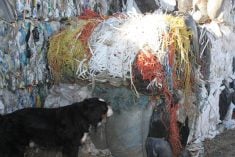CALGARY – Ted Haney, a second-time Liberal candidate in the Calgary Nose Hill riding and on leave from his position as president of Canada Beef Export Federation, has a theory about why so many farm leaders end up in organized politics.
“Politics is a way of life in agriculture and if you are in that, it becomes obvious very quickly that so much of agriculture’s fate depends on politics and policy decisions made here and abroad,” he said last week. “Politics affects us so directly that the value of being involved in that process directly is obvious.”
Read Also

Message to provincial agriculture ministers: focus on international trade
International trade stakeholders said securing markets in the face of increasing protectionism should be the key priority for Canada’s agriculture ministers.
Don Dewar, former president of Manitoba’s Keystone Agricultural Producers and a second-time Liberal candidate in Dauphin-Swan River riding, figures the appeal cuts both ways.
Political parties see the benefit of trying to recruit farm lobby veterans as candidates.
“The parties look to farm leaders both for their name recognition and the respect they have in the community, but also because they have been involved in the system and understand at least a bit how it works,” he said.
Ted Menzies, a former Western Canadian Wheat Growers’ Association president who was elected a Conservative MP for the Alberta riding of Macleod in 2004, notes that a quarter of the 2004 Conservative caucus were farmers. In his own riding association, farmers are the core activists.
“I think farmers get involved in politics because like myself, they get frustrated when they see what needs to be done and make their arguments from the outside but can’t seem to get anything done,” he said. “At some point, they want to get involved inside to try to make things happen.”
This trio of former farm leaders trying their hand at federal politics represent a striking trend – next to lawyers, farmers are one of the most represented professions among federal politicians and candidates.
In the last Parliament, Menzies and Liberal Wayne Easter, former president of the National Farmers Union, were part of the large contingent of MPs who claimed a connection to the farm.
The current election campaign features a bevy of prominent farm representatives running for all parties – Easter, Dewar, Haney and former NFU president Cory Ollikka are Liberal candidates, former NFU president Nettie Wiebe is a Saskatchewan New Democratic Party candidate and Menzies is joined by former Manitoba Cattle Producers’ Association general manager and one-term MP James Bezan as prominent Conservative candidates.
In 2004, Canadian Federation of Agriculture president Bob Friesen ran for a Manitoba Liberal nomination, only to be defeated by farmer Murray Downing.
Other farm leaders report having been courted by various political parties.
“Farmers feel comfortable making the switch because whether it is trade or domestic support or regulation, they deal with political issues all the time and get to understand their importance and some solutions,” said Menzies.
The most startling recent political coming out party happened in 2004 when Haney, prominent in the typically Conservative cattle industry, emerged as a Liberal candidate in an urban Calgary riding he had little hope of winning.
He says now, in the midst of his second attempt to become an MP, that his Liberalism has not hurt him in the industry and it may have helped the cattle cause.
Haney said the cattle industry has long been seen as a close affiliate of the Conservatives. He said his candidacy has helped build a bridge between the Liberals and the industry, improving relations and helping get more favourable attention and policies from Ottawa.
“There is a fuzzy line between what I do in the writ (election) period and what I do between the writs,” he said.
Haney suggested bridges he had helped build included heavy government support for the cattle industry during BSE, a decision to send Canadian Food Inspection Agency veterinarians abroad and Ottawa’s support for the industry’s $50 million legacy fund to promote markets.














